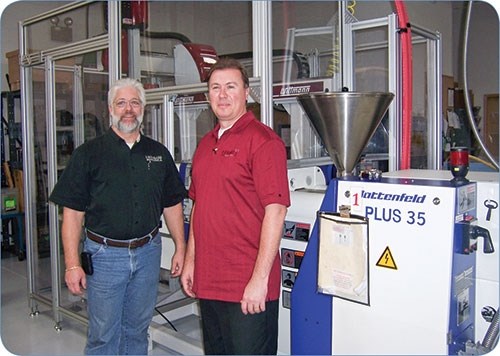A Legacy Built on Automation
Automated molding cell pays off big for Florida processor.
Have any doubts that automation can pay off? Run them by custom molder Legacy Custom Plastics LLC in Clearwater, Fla.
Undeterred by the Great Recession of 2009, Legacy (legacycustomplastics.com) decided in the summer of that year that it was time to look for a more productive way to produce a tight-tolerance insert-molded part used for water meters. Teaming up with Wittmann Battenfeld Inc., Torrington, Conn., (wittmann-ct.com), Legacy installed a turnkey insert-molding work cell that has boosted its productivity by 46%. That’s a big number for any molder, especially for a $4-million, 36-employee operation that runs 27 presses from 35 to 500 tons in two plants totaling 24,000 ft2 with 5000 ft² devoted to moldmaking.
The new system all but eliminated the need for operator involvement with this particular part, which Legacy runs at a rate of about 45,000 a week. The tiny part (photo) is made of a proprietary grade of nylon 12 with a metal pin insert. Before this recent installation, the pins were inserted manually into the four-cavity mold by an operator, who would then close the safety gate to start the molding cycle. The new automated system allows Legacy to meet production requirements running only two shifts, three days a week, says Darryl Crowe, who owns and runs the business together with Daniel Redmond.
The cell consists of a new tight-tolerance pin-insertion automation system and a new Wittmann Battenfeld Plus Series 35-ton hydraulic press, which runs the existing hot-runner precision mold built by Legacy.
The press is equipped with the Battenfeld B2 closed-loop control system. Mold-open repeatability is particularly critical for insert molding, especially when the inserts are loaded into the B-side of the mold, and the B2 controller holds a mold-open position to within ± 0.0004 in. The press also features an energy-efficient, variable-displacement pump with proportional valves for velocity and pressure control; a two-tiebar clamping system with maintenance-free, greaseless tiebars; and a compact 13 x-5 ft footprint.
AXIAL-MOUNTED ROBOT
The cell also features a servo-driven Wittmann W711 modular Z-beam traversing robot. The robot is longitudinally mounted along the machine axis, minimizing the footprint while keeping the work cell “inline” to ease setup and maintenance. The robot has precision end-of-arm tooling to handle the tight-tolerance placement of pin inserts in the mold. The color touchscreen pendant controller was preprogrammed for the automation sequence and has editing features to allow Legacy to “tweak” and “dial-in” the sequence before, during, and after installation. Wittmann also designed and built a bowl feeder and escapement system to feed and present the insert pins to the robot.
While the work cell was being engineered, Crowe, Redmond, and their team reviewed the mold design and made minor enhancements to facilitate automated pin-loading. All told, Legacy estimates payback for the entire system to be less than a year, and anticipates adding more automated cells in the future.
Related Content
-
What to Look for in High-Speed Automation for Pipette Production
Automation is a must-have for molders of pipettes. Make sure your supplier provides assurances of throughput and output, manpower utilization, floor space consumption and payback period.
-
Drones and Injection Molding Ready for Takeoff
Drones and unmanned aerial vehicles (UAV) are approaching an inflection point where their production volumes — and functionality — will increasingly point to injection molding.
-
BMW Group Vehicle to Adopt 3D Printed Center Console
A vehicle coming to market in 2027 will include a center console carrier manufactured through polymer robot-based large-format additive manufacturing (LFAM).










